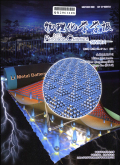物理化学学报2024,Vol.40Issue(3):44-45,2.DOI:10.3866/PKU.WHXB202305012
NiFe-MOF和氮氧自由基协同增强甾醇电催化氧化
Enhanced Electrocatalytic Oxidation of Sterols using the Synergistic Effect of NiFe-MOF and Aminoxyl Radicals
摘要
Abstract
Conventional oxidation methods of sterol intermediates using the heavy metal chromium as an oxidant has critical drawbacks,such as high toxicity and environmental pollution.Electrocatalytic oxidation(ECO),on the other hand,is considered a promising alternative to conventional processes owing to its high efficiency,eco-friendliness,and controllability.However,ECO currently faces two major challenges:low current densities and reduced space-time yields.In this study,a single-step solvothermal method was employed to synthesize self-supported nickel-iron metal-organic framework(NiFe-MOF)nanosheet electrocatalysts on graphite felt.Various analytical techniques were employed to comprehensively characterize the synthesized NiFe-MOF,including scanning electron microscopy(SEM),X-ray photoelectron spectroscopy(XPS),X-ray diffraction(XRD),Raman spectroscopy,and Brunauer-Emmett-Teller(BET)analysis Furthermore,we implemented a synergistic electrocatalytic strategy by combining the NiFe-MOF catalyst with aminoxyl radicals,i.e.,4-acetamido-2,2,6,6-tetramethyl-1-piperidine-N-oxyl(ACT),to enhance the performance of the ECO reaction.According to the results of structural characterization,the synthesized NiFe-MOF exhibited an amorphous nanosheet structure with a high specific surface area and microporosity.Moreover,we successfully achieved continuous flow with enhanced mass transfer during the electrocatalytic oxidation of 19-hydroxy-4-androstene-3,17-dione(1a)at a current density of 100 mA·cm-2.The optimal reaction conditions for the ECO reaction were as follows:100 mmol·L-1 concentration of 1a,10%(molar fraction)of ACT,a 1 mol·L-1 Na2CO3/acetonitrile electrolyte(6:4),room temperature,pH 12.5,and a flow rate of 225 mL·min-1.Under these conditions,the conversion and selectivity of the reaction reached outstanding levels of 99 and 98%,respectively.Moreover,the space-time yield was calculated to be as high as 15.88 kg·m-3·h-1,with a remarkable 35-fold increase compared to that achieved in a batch reactor.The NiFe-MOF/ACT synergistic system demonstrated a high conversion rate for ECO even after 10 reaction cycles.To assess the system's efficacy in converting other sterols,we conducted an analysis of substrate expansion,which yielded conversion rates exceeding 95%.The SEM,TEM,and XPS results of the catalyst obtained before and after the reaction indicated that the alkaline electrolyte could effectively reconstitute the NiFe-MOF structure,leading to a significant improvement in its performance.By leveraging a ten-fold increased surface area of the NiFe-MOF and constructing a continuous flow electroreactor for ECO with a constant current,we achieved a remarkable space-time yield of 12.99 kg·m-3·h-1.Thus,we developed a synergistic electrocatalytic oxidation strategy based on NiFe-MOF/ACT,and this study not only provides valuable insights for realizing the selective oxidation of sterols but also contributes to the advancement of sustainable and efficient chemical processes.关键词
甾醇/电催化氧化/金属有机框架/氮氧自由基/协同作用Key words
Sterol/Electrocatalytic oxidation/Metal-organic frameworks/Aminoxyl radical/Synergistic effect分类
化学引用本文复制引用
许银洁,钟兴,王建国,李随勤,刘力豪,贺佳辉,李凯,王梦欣,赵舒影,李纯,张峥斌..NiFe-MOF和氮氧自由基协同增强甾醇电催化氧化[J].物理化学学报,2024,40(3):44-45,2.基金项目
The project was supported by the National Key Research and Development Program of China(2022YFA1504200,2021YFA1500903),the Zhejiang Provincial Natural Science Foundation(LR22B060003),and the National Natural Science Foundation of China(22078293,21625604,91934302,22141001).国家重点研发计划(2022YFA1504200,2021YFA1500903),浙江省自然科学基金(LR22B060003)和国家自然科学基金(22078293,21625604,91934302,22141001)资助项目 (2022YFA1504200,2021YFA1500903)

